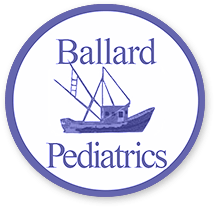Common Health Issues
Health Information
We have designed this page to answer general questions about common childhood health concerns and medications. If you have an urgent concern and the information provided here does not fit your child's specific problem, please contact us by telephone at 206-783-9300 to speak to one of our nurses during regular office hours. After hours, your call will be directed to one of the Children's On-Call nurses who will return your call as soon as possible. For life-threatening emergencies (severe difficulty breathing, unconsciousness, seizures, or severe head injury) call 911 immediately.
The health information on this site is intended for the exclusive use of the patients of the Ballard Pediatric Clinic. Please refer to the disclaimer.
Dosing Guidelines
Acetaminophen (Tylenol, paracetamol, APAP):
***Important Dosing Changes: Starting in Fall 2011, manufacturers of acetaminophen will begin to discontinue Infant Drop formulations (80mg per 0.8mL). This is an attempt to avoid dosing errors caused by caregiver confusion over different concentrations. Acetaminophen will be moving to a single pediatric concentration of 160mg per 5mL for Infants' suspension liquid and Children's suspension liquid. Please be sure to confirm the concentration of acetaminophen before following dosing parameters below:
Infant drops
Concentration: 80mg per 0.8mL
(may not be available much longer)
- 12 to 18 pounds: 0.8mL (80mg) each 4-6 hours
- 18 to 24 pounds: 1.2mL (120mg) each 4-6 hours
- 24 to 30 pounds: 1.6mL (160mg) each 4-6 hours
Infant drops
(50mg per 1.25mL)
- 11 to 17 pounds: 1 dropper = 1.25mL (50mg) each 6-8 hours
- 18 to 22 pounds: 1 ½ droppers = 1.875mL (75mg) each 6-8 hours
Children's suspension
(100mg per teaspoon):
- 11 to 17 pounds: 2.5ml = 1/2 teaspoon (50mg) each 6-8 hours
- 18 to 22 pounds: 3.8ml = 3/4 teaspoon (75mg) each 6-8 hour
- 23 to 30 pounds: 5ml = 1 teaspoon (100 mg) each 6-8 hours
Suspension
Concentration: 160mg per 5mL
- 10 to 12 pounds: 2mL (64mg) each 4-6 hours
- 12 to 18 pounds: 2.5mL (80mg) each 4-6 hours
- 18 to 24 pounds: 3.75mL (120mg) each 4-6 hours
- 24 to 30 pounds: 5mL or (160mg) each 4-6 hours
Abdominal pain
Mild abdominal pain in children is very common, and may be caused by viral illness, overeating, over-stimulation, or constipation. More severe abdominal pain, especially if accompanied by fever or vomiting, may be a sign of more serious illness such as appendicitis or urinary infection. Call the office for advice at 206-783-9300 if your child's abdominal pain is severe and has persisted for longer than four hours, or fever/vomiting are present.
Acetaminophen: (Tylenol, paracetamol, APAP)—see dosage table above
Advil: (ibuprofen)—see dosage table above
Constipation
Constipation in infants and children refers to hard, painful bowel movements. Stools that are soft are normal, and may be as infrequent as every 2 or 3 days in normal, healthy infants and children. In toddlers and older children, constipation can usually be relieved by increased amounts of liquids in the diet, especially pear juice and prune juice, and by increased amounts of fruits and vegetables. For infants who have hard, painful stools, or in older children who do not improve with a change in diet, please call during office hours to talk with one of the nurses for further advice at 206-783-9300.
Dehydration
Excessive loss of body fluids through vomiting or diarrhea, combined with inadequate oral intake of fluids, can lead to dehydration in infants and small children. Signs of dehydration include infrequent urination (fewer than 3 times in 24 hours), dry lips and tongue, sunken eyes, and skin that has a “doughy” feel, or which remains tented up when gently squeezed between your thumb and forefinger. Lack of tears or saliva are also signs of dehydration. If your child appears to be dehydrated, please call the office for advice, at 206-783-9300.
Diarrhea
Diarrhea is a common childhood condition usually caused by an intestinal virus. Frequent loose or watery stools may occur, accompanied by low-grade fever. If your child is otherwise well, taking fluids without vomiting, and urinating at least once every eight hours, it is acceptable practice to continue feeding the child's usual diet and expect the diarrhea to resolve in 3-4 days. In the toddler or older child it may be helpful to eliminate milk and other dairy products (which contain lactose) from the diet for a day or two. If diarrhea is accompanied by severe abdominal pain, high fever, or blood in the stool, please call the office for advice at 206-783-9300.
If diarrhea is accompanied by vomiting, please consult that topic on this site. If you are concerned that your child may be dehydrated, please consult that topic or call our office.
Fever
Fever (rectal temperature above 100.5 degrees F) is usually a sign that your child's immune system is responding to an infection of some kind. Most of these infections are caused by viruses and involve only mild signs of illness or discomfort. Most of these viral infections subside in 3-4 days, and for infants over six months of age and older children, only comfort care is necessary, which includes fever-reducing medications (see above).
If fever is accompanied by severe sore throat, headache, vomiting, diarrhea, rash, difficulty breathing, pain with urination, abdominal pain, or confusion, please consult those specific topics on this site or call to talk with the consulting nurse at 206-783-9300.
Fever in an infant less than three months old may represent a serious infection. Call us immediately at 206-783-9300 for an urgent appointment. Infants over three months old may have a mild fever accompanying a cold. If the infant is otherwise well, except for cold symptoms, only careful observation is necessary. Fever that appears after several days of cold symptoms may indicate a secondary bacterial infection—call the office for advice. If your infant has a high fever not accompanied by signs of a cold, or if the infant appears ill or very fussy, call us at 206-783-9300 to discuss your child's symptoms and to decide whether a visit to the office, after-hours clinic, or emergency room may be necessary.
Headache
Children often have headaches associated with viral infections, overheating, or mild dehydration. These headaches are usually brief and respond to comfort measures such as rest, fluids, and medications such as acetaminophen or ibuprofen. Headaches may also follow minor head injury and also respond to comfort measures.
If headache is severe, or accompanied by vomiting, fever, confusion, or stiff neck, call our office immediately at 206-783-9300 for advice.
If your child develops a pattern of frequent or severe headaches, especially if they interfere with normal activities or occur first thing in the morning, call the office to arrange for an evaluation.
Head Lice
Rash
Most rashes in infants and children accompany mild viral infections and look like scattered red dots and bumps that are not itchy or painful. Rashes occasionally are a sign of a serious infection—specifically rashes that are purplish, do not disappear with pressure from a finger, and are accompanied by fever and/or headache. Call our office immediately (206-783-9300) if you observe a purplish rash. Some rashes can be diagnosed over the telephone—if a rash persists for a week or more, please call the office. If a rash occurs while your child is taking an antibiotic or other prescription medication, call the office for advice.
Respiratory Distress
Here are a few resources to help you assess your child’s breathing status and how to care for them at home if they do not need urgent medical attention.
Sore throat
Most sore throats in children are mild and are caused by viruses that last 3-4 days before resolving on their own. Comfort measures include cool liquids, bland foods, and appropriate doses of pain medication such as acetaminophen or ibuprofen. More severe infections in children over 18 months can be caused by the Streptococcus bacteria (“strep throat”). Clues that your child's sore throat might be due to strep are sudden onset, headache and abdominal pain, enlarged tonsils (which may be red or show white patches), and enlarged, tender lymph nodes on either side of the neck (“swollen glands”). Typical cold symptoms such as runny nose or cough are often absent. Occasionally a fine red “sandpapery”-feeling rash may occur under the arms or in the groin. If you suspect your child may have a sore throat due to strep, please call the office for an appointment. If laboratory tests indicate that a strep infection is present, an antibiotic is the appropriate treatment.
Tylenol (acetaminophen): see table above
Travel Visits
If you require vaccines, medicines or advice on traveling abroad, we recommend scheduling a visit with Katterman's Pharmacy. They offer a wide range of services relating to travel including traveler's diarrhea, antibiotics, vaccinations (malaria, typhoid, etc.) insect avoidance, motion sickness, etc.
Click the following link to schedule an appointment: kattermans.com/travel-consults/
Urination, pain with:
Pain with urination is commonly accompanied by fever, frequent urination, and abdominal or back pain. These symptoms often indicate a urinary tract infection, and should be evaluated in the office within 24 hours. Call 206-783-9300 for an appointment. In the meantime, comfort measures such as acetaminophen or ibuprofen may be used. Increased intake of oral liquids, especially cranberry juice, may also be helpful.
Vomiting
Vomiting in children commonly occurs in the early stages of an intestinal viral infection (“stomach flu”) and may also be a sign of food poisoning. Vomiting may also be a sign of rare but serious conditions such as intestinal obstruction or appendicitis. If your child is NOT vomiting green material (bile) and does NOT have a high fever or severe abdominal pain, it is safe to try comfort measures for the first six hours at home. After the stomach is empty and your child's vomiting has ceased for one to two hours, begin rehydration using small amounts (1/2 to 1 Tablespoon) of clear liquids such as Pedialyte (our first choice for infants), or 1/2-strength Gatorade, or water. Offer these every 15 to 20 minutes while your child is awake, gradually increasing the amounts. If your child is breastfeeding you may resume nursing, but try limiting the duration and increasing the frequency of nursing.
If vomiting is bile-colored (lime-green) or persists for longer than six hours, or is accompanied by high fever, severe abdominal pain, or signs of dehydration, please call the office at 206-783-9300 to speak with one of the consulting nurses.
When vomiting has ceased for eight hours and your child is tolerating 4 ounces of clear liquids at a time, it should be safe to begin feeding your child small amounts of food. Foods that are well-tolerated include carbohydrates such as rice, white bread, white potato, pasta (except whole wheat), jello, rice milk, soy milk, or soy formula. Observe this diet for 24-36 hours, and then resume your child's regular foods.
Note: 5mL = 1 measured teaspoon
Ibuprofen (Advil, Motrin):
We do not recommend using Ibuprofen products prior to 6 months of age.
Motrin (ibuprofen): See chart above.



